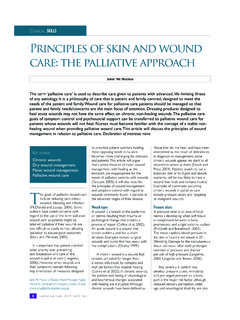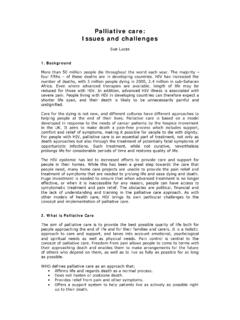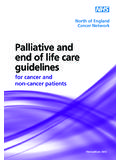Transcription of symp tom man age ment and end-of-life care - who.int
1 palliative Care: symp tom man age ment and end -of-life careINTEGRATEDMANAGEMENT OFADOLESCENT AND ADULTILLNESSINTERIM GUIDELINES FOR FIRST LEVEL FACILITY HEALTH WORKERSJune 2004 WHO/CDS/ Rev. 1 TABLE OF CONTENTS How to Use the palliative Care Module ..P5 Assess and Treat the Patient ..P6 Teach Patient/Family to Give palliative Care at Home ..P9 How to Use the Caregiver Booklet .. P10 Management of Pain Assess the Patient for Pain .. P11 Treat the Pain .. P11 Treat Chronic Pain .. P12 Use of Opioid and Non-Opioid Analgesics .. P13 Side Eff ects of Morphine or Other Opioids .. P14 Medications for Special Pain Problems .. P15 Teach Family How to Give Pain Medications for Pain Control .. P16 Advise Family on Additional Methods for Pain Control .. P16 Teach Family to Give Oral Morphine .. P17 Preventive Interventions for All Patients Oral Care ..P19 Prevent Bedsores .. P19 Bathing .. P20 Prevent Pain, Stiff ness and Contractures in Muscles.
2 P20 Moving the Bedridden Patient .. P22 Manage Key Symptoms Weight Loss .. P23 Nausea and Vomiting .. P23 Mouth Ulcers .. P24 Pain on Swallowing .. P24 Dry Mouth .. P25 Constipation .. P25 Incontinence of Stool and Urine .. P26 Vaginal Discharge From Cervical Cancer .. P26 Diarrhoea .. P27 Anxiety and Agitation .. P28 Trouble Sleeping .. P28 Dementia or Delirium .. P29 Depression .. P29 palliative care includes symptom management during both acute and chronic illness and end -of-life (terminal) care. This module provides guidelines to prepare health workers to provide palliative care treatment and advice in clinic and to back up community caregivers and family members who need to provide home-based palliative care. For each symptom, the guidelines for the health worker include both a summary of non-pharmaceutical recommendations for home care and the clinical management and medications which the health worker might also provide, based on a limited essential drug list on the last page of this module.
3 Alternative or additional drugs can be added during country adaptation. The home care advice also appears in a Caregiver Booklet which is illustrated. Health workers should use it to prepare families and community-caregivers to care for patients at home. This needs to be locally adapted. How to contact IMAI project in WHO Geneva: INTERIM GUIDELINES FOR FIRST-LEVEL FACILITY HEALTH WORKERS IN LOW-RESOURCE SET TINGS World Health Organization 2004 This is one of 4 IMAI modules relevant for HIV care: These modules include:1. Acute Care (including opportunistic infections, when to suspect and test for HIV, prevention).2. Chronic HIV Care with ARV General Principles of Good Chronic palliative Care: Symptom Management and end -of-Life ..P30 Bedsores .. P30 Cough .. P32 Fever .. P34 Hiccups .. P34 Special Considerations For patients with HIV/AIDS .. P35 ARV Therapy Side Eff ects .. P37 Sexuality in end-of-life Care.
4 P38 Management of Children .. P39-P42 Support for Caregivers .. P43 Burn-out .. P44 end-of-life CarePsychosocial and Spiritual Support .. P45 Special Advice for end-of-life Care .. P46 Signs of Imminent Death .. P47 Signs of Death .. P47 Bereavement Counselling .. P48 Essential Drugs for palliative Care from First-Level Facilities .. P49 How to Use the IMAI palliative Care Module The IMAI palliative Care module cross-references guidelines in the IMAI Acute Care and the HIV Care modules. For acute problems, fi rst use the Acute Care module. If emergency signs are present, use the Quick Check and Emergency Treatment providing care, both specifi c treatment for the illness and treatment to relieve symptoms are needed. Often you will use this module as part of a treatment plan for a specifi c condition; the indications for antimicrobials and other specifi c treatments are in the Acute Care module.
5 If new signs and symptoms, use the Acute Care module or other guidelines to assess, classify the illness, and provide specifi c treatment. You need to decide whether home care advice is suffi cient or if it is necessary to also prescribe response to pain and other symptoms is included in this module. Nurses or other fi rst level facility health workers will usually need to consult with medical doctors, medical offi cer or specialist palliative care nurses for: morphine prescription decision that the patient is terminal use of steroids in end-of-life carePatients on treatment for tuberculosis should continue treatment to prevent spread to others and for their own well-being use the Tuberculosis guidelines. Caregivers may also be TB treatment supporters for Directly Observed should be sent from any patient with a new, productive cough more than 2 of Contents continued:instructionsP6P73.
6 Respond to volunteered problemsFever Very severe febrile disease (malaria or meningitis) Malaria Persistent fever Other causesSymptomatic management of fever P32 Diarrhoea Severe/some/no dehydration Persistent diarrhoea DysenteryFluid management Rectal careConstipating medications P25 Female GU symptoms or lower abdominal pain STI/UTI Menstrual problems Detect pregnancy Pregnancy related bleeding Severe/surgical abdominal problemVaginal discharge from cervical cancer P24 Male GU symptoms or lower abdominal pain STI Prostatic obstruction Severe/surgical abdominal problemAnogenital sore, ulcer or warts Anogenital herpes/ulcer Inguinal bubo Genital wartsSkin problem or lump Suspicious node or mass Reactive lymphadenopathy Soft tissue Muscle infection PGL Folliculitis Impetigo Abscess Prurigo Eczema Dry itchy skin Ringworm Scabies Leprosy Herpes zoster Seborrhoea Psoriasis Pressure sores ARV toxicityItching P28 Prevent bedsores P19 Treat bedsores P28 Headache or neurological problem Serious neurological problems Sinusitis/migraine/tension headache Painful leg neuropathy Delirium/dementia/normal agingAmitriptyline for neuropathy P15 Manage confusion P27 Mental problem Alcohol.
7 Withdrawal/hazardous or harmful alcohol use Suicide risk Depression Diffi cult life events Loss Possible psychosis Anxiety disorderDepression P27 Anxiety P26 Trouble sleeping P26 Nausea or vomitingP23 Contractures/stiff nessPrevention of contractures/stiff ness P20 Constipation, incontinencePrevent/heal constipation P25 HiccupsP34 Assess patient:Give specifi c treatment based on classifi cations:(use IMAI Acute Care module to assess, classify, identify specifi c treatments, treat and advise/counsel) for emergency signsManage symptoms:home care and clinical/medication management 1. Quick check Includes airway and breathing, circulation, chest pain, severe abdominal pain, neck pain or severe headache, fever from life-threatening cause. If emergency signs, give emergency treatments Acute pain managementAcute pain 2. Check in all patients:Cough or diffi cult breathing Pneumonia (antibiotics) Severe pneumonia or other severe disease (antibiotics plus referral) Suspect TB send sputums Possible chronic lung disease Cough or cold/bronchitis Wheezing (bronchodilators) Bothersome coughP31-33 Excessive sputum DyspnoeaUndernutrition or anaemia Severe undernutrition Signifi cant weight loss Severe or some anaemia (iron, mebendazole) Weight loss P22 Mouth problems P23 Mouth or throat Oral thrush (fl uconazole/nystatin) Esophageal thrush (fl uconazole) Oral hairy leukoplakia (no treatment) Tonsillitis Strept, non-strept sore throat Gum/mouth ulcers Gum disease Dental abscess, tooth decay Ulcers symptomatic management for herpes and apthous ulcers P23 Oral care (all)
8 P19 Dry mouth P23 PainLook for cause Chronic Pain P8-17 Acute pain P18 Assess the Patient, Give Specifi c Treatment and Manage SymptomsWhen providing care, both specifi c treatment for the illness and treatment for symptoms are needed. For all palliative care, consult with the patient, explain the options, and involve the patient in choice of management where possible. Use the General Principles of Good Chronic Care. instructionsThis palliative Care module and the Caregiver Booklet address thisP9 Teach the patient and family how to give good palliative care at home according to the symptoms Give home care interventions which will relieve the patient s symptoms, using the Caregiver Booklet. Give pain medications (P13-15) and other medications. Use other methods for pain control (P16). Give information and teach skills. Use the Caregiver Booklet to educate the patient, family and community caregivers.
9 The content of columns entitled Home Care on pages P20 to P32 is from the Caregiver Booklet. This booklet also has illustrations. Record medications with instructions Use a separate sheet of paper with the name of each medication, what it is for, and the dose. Leave the patient as much in charge of his or her own care as possible Support the patient to give as much self-care as possible. Discuss with the patient who should provide hands-on care. Examples of non-medical treatment for pain, in addition to analgesics and special pain medications (adapt locally): Support and counselling. - Psychological, spiritual and emotional support and counselling should accompany pain medications. Pain can be harder to bear when there is guilt, fear of dying, loneliness, anxiety, depression. Answering questions and explaining what is happening is important to relieve fear and anxiety.
10 Deep breathing and relaxation techniques unless the patient is psychotic or severely depressed. Distraction, music, imagining a calm Care at HomeP10P11 Assess the patient for pain (in all patients) Determine the cause of the pain by history and examination (for new pain and any change in pain). Where is the pain? What makes it better/worse? Describe it. What type of pain is it? What are you taking now for the pain? Use the Acute Care guidelines to determine if there is an infection or other problem with specifi c treatment. Prompt diagnosis and treatment of infection is important for pain control. Determine the type of pain is it common pain (such as bone or mouth pain) or special pains (such as shooting nerve pain, zoster, colic or muscle spasms)? Is there a psychological or spiritual component? Grade the pain with the FACES (especially in children) or with your hand (with 0 being no pain, 1 fi nger very mild pain and 5 fi ngers the worst possible pain).
















